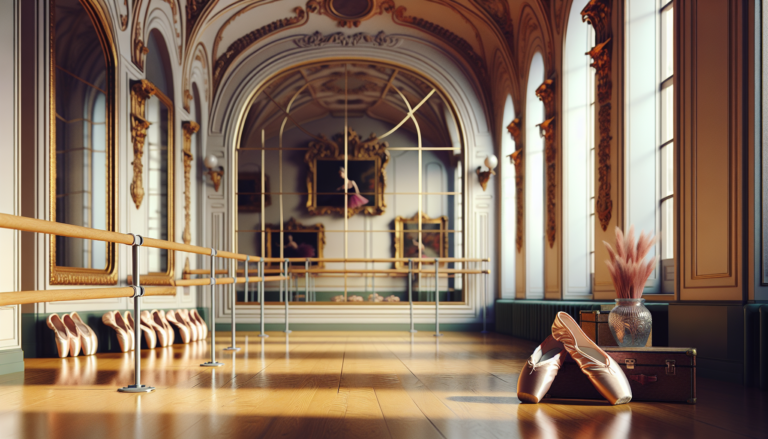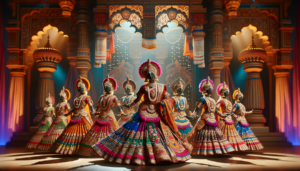Ballet is a timeless art form that has captivated audiences for centuries. With its graceful movements, expressive storytelling, and breathtaking performances, ballet has become a beloved dance style around the world. From its humble beginnings in the royal courts of Europe to its evolution into a diverse and dynamic art form, ballet continues to inspire and enchant dancers and spectators alike.
In this comprehensive exploration of ballet, we will delve into its rich history, examine the various techniques and styles, highlight famous ballet dancers, showcase prominent ballet companies and schools, and celebrate iconic ballet performances and productions. Whether you are a seasoned ballet enthusiast or a curious newcomer, this article will provide a deep appreciation for the artistry, dedication, and passion that defines the world of ballet.
The Rich History of Ballet
Origins of Ballet
The roots of ballet can be traced back to the Italian Renaissance courts of the 15th and 16th centuries. It was during this time that dance began to evolve from a social pastime into a formal art form. The earliest ballets were performed in large halls, with dancers wearing elaborate costumes and masks. These early performances often celebrated special occasions and were attended by nobility and aristocrats.
In the late 16th century, ballet spread to France, where it was further refined and codified. The French king Louis XIV, known as the “Sun King,” was a passionate supporter of the arts and played a crucial role in the development of ballet. He established the Académie Royale de Danse in 1661, which set the standards for ballet training and technique that are still followed today.
Evolution of Ballet Through the Centuries
As ballet continued to evolve, it began to incorporate more complex movements, intricate footwork, and expressive gestures. The 18th century saw the rise of the ballet d’action, which emphasized storytelling through dance. This period also marked the emergence of female dancers in leading roles, with ballerinas like Marie Camargo and Marie Sallé challenging traditional gender roles and pushing the boundaries of the art form.
The 19th century is often considered the golden age of ballet. This era witnessed the birth of classical ballet, characterized by its emphasis on technique, pointe work, and ethereal grace. Iconic ballets such as “Swan Lake,” “The Nutcracker,” and “Sleeping Beauty” were created during this time, showcasing the talents of legendary choreographers like Marius Petipa and Lev Ivanov.
Modern Ballet Movements
In the early 20th century, ballet experienced a period of innovation and experimentation. Choreographers like Sergei Diaghilev and his Ballets Russes company brought a fresh perspective to the art form, incorporating elements of modern dance, avant-garde design, and cross-cultural influences. This period saw the emergence of groundbreaking works like “The Rite of Spring” and “Les Noces,” which challenged traditional ballet conventions.
The latter half of the 20th century witnessed the rise of contemporary ballet, which blends classical technique with modern dance elements. Choreographers like George Balanchine, Jerome Robbins, and William Forsythe pushed the boundaries of ballet, creating works that were both technically demanding and emotionally powerful. Today, ballet continues to evolve, with choreographers and dancers exploring new ways to express themselves through movement.
Techniques and Styles in Ballet
Classical Ballet Techniques
Classical ballet is characterized by its strict adherence to codified techniques and vocabulary. At the core of classical ballet training are five basic positions of the feet, which serve as the foundation for all movements. Dancers must master a wide range of steps, including pliés, tendus, relevés, and pirouettes, all executed with precision and grace.
Pointe work, where dancers balance and execute steps on the tips of their toes, is a hallmark of classical ballet. This highly demanding technique requires years of training and conditioning to develop the strength, control, and artistry necessary to perform on pointe.
Famous classical ballet techniques include the French School, known for its elegance and refinement, and the Russian (Vaganova) method, renowned for its athleticism and expressiveness. These techniques have been passed down through generations of dancers and continue to shape the art form today.
Contemporary Ballet Techniques
Contemporary ballet incorporates elements of modern dance, jazz, and other styles to create a more fluid and expressive form of movement. While still rooted in classical technique, contemporary ballet allows for greater freedom and experimentation in terms of choreography, music, and staging.
Contemporary ballet often explores complex themes and emotions, with choreography that emphasizes individuality and artistic interpretation. Dancers are encouraged to bring their own unique qualities and experiences to their performances, resulting in a more diverse and dynamic art form.
Notable contemporary ballet choreographers include Jiří Kylián, Nacho Duato, and Crystal Pite, who have pushed the boundaries of what is possible in ballet, creating works that are both visually stunning and emotionally resonant.
Famous Ballet Choreographies
Throughout history, ballet has produced countless iconic choreographies that have captivated audiences and left an indelible mark on the art form. Some of the most famous ballet choreographies include:
- Swan Lake: Created by Marius Petipa and Lev Ivanov, this timeless classic tells the story of a princess turned into a swan by an evil sorcerer’s curse.
- The Nutcracker: A beloved holiday tradition, this ballet by Petipa and Ivanov follows a young girl’s magical journey through a fantastical world of snow and sweets.
- Giselle: A haunting tale of love, betrayal, and redemption, this romantic ballet showcases the power of forgiveness and the enduring nature of true love.
- Romeo and Juliet: Set to Prokofiev’s lush score, this ballet adaptation of Shakespeare’s tragic love story captures the passion and drama of the original play.
These enduring works continue to be performed by ballet companies around the world, captivating new generations of audiences with their timeless beauty and emotional depth.
Famous Ballet Dancers
Pioneers of Ballet
Throughout history, numerous ballet dancers have left an indelible mark on the art form, pushing the boundaries of technique and artistry. Some of the most celebrated pioneers of ballet include:
- Anna Pavlova: A Russian ballerina of the early 20th century, Pavlova was renowned for her grace, expressiveness, and signature role in “The Dying Swan.”
- Vaslav Nijinsky: A virtuoso dancer and choreographer, Nijinsky’s explosive leaps and avant-garde works like “The Rite of Spring” revolutionized ballet.
- Margot Fonteyn: An English ballerina known for her elegance and purity of line, Fonteyn formed a legendary partnership with Rudolf Nureyev.
- George Balanchine: A visionary choreographer, Balanchine co-founded the New York City Ballet and created a vast repertoire of neoclassical works that shaped the course of 20th-century ballet.
These trailblazing artists set the stage for future generations of dancers and continue to inspire and influence the world of ballet today.
Modern Ballet Icons
In recent decades, a new generation of ballet stars has emerged, captivating audiences with their technical brilliance, artistic versatility, and charismatic stage presence. Some of the most iconic modern ballet dancers include:
- Mikhail Baryshnikov: A Soviet-born dancer known for his powerful leaps and acting abilities, Baryshnikov’s defection to the West in 1974 made headlines around the world.
- Sylvie Guillem: A French ballerina renowned for her astonishing flexibility and contemporary sensibilities, Guillem redefined the boundaries of classical ballet.
- Alessandra Ferri: An Italian prima ballerina known for her dramatic intensity and expressive performances, Ferri has had a long and illustrious career spanning over three decades.
- Carlos Acosta: A Cuban-born dancer celebrated for his athleticism and artistry, Acosta has become an international star and a role model for aspiring dancers of color.
These extraordinary artists have not only achieved great success on stage but have also used their platforms to advocate for greater diversity, equity, and inclusion in the world of ballet.
Rising Stars in Ballet
The future of ballet is in good hands, with a new generation of talented dancers poised to take the art form to new heights. Some of the most promising rising stars in ballet today include:
- Misty Copeland: The first African American woman to be promoted to principal dancer at the American Ballet Theatre, Copeland is a trailblazer and role model for young dancers everywhere.
- David Hallberg: An American dancer known for his technical precision and artistic sensitivity, Hallberg made history as the first American to join the Bolshoi Ballet as a principal dancer.
- Francesca Hayward: A British ballerina of Kenyan and English descent, Hayward is a rising star at the Royal Ballet, captivating audiences with her exquisite musicality and ethereal stage presence.
- Calvin Royal III: A dynamic and versatile dancer, Royal is making waves at the American Ballet Theatre with his powerful performances and commitment to increasing diversity in ballet.
These talented young artists are not only pushing the boundaries of what is possible in ballet but are also inspiring a new generation of dancers to pursue their dreams and express themselves through this timeless art form.
Prominent Ballet Companies and Schools
Renowned Ballet Companies
Ballet companies around the world play a vital role in preserving the art form’s rich history while also pushing it forward with innovative productions and fresh talent. Some of the most renowned ballet companies include:
- The Royal Ballet: Based at the Royal Opera House in London, this esteemed company has a long history of excellence and is known for its classical repertoire and commitment to new works.
- American Ballet Theatre: Founded in 1939, ABT is one of the premier classical ballet companies in the United States, known for its diverse repertoire and international roster of star dancers.
- Paris Opera Ballet: The oldest national ballet company in the world, the Paris Opera Ballet is renowned for its elegant French style and has been home to many of the greatest dancers and choreographers in history.
- Bolshoi Ballet: Based in Moscow, the Bolshoi Ballet is known for its grand productions, technical brilliance, and larger-than-life stage presence.
These companies, along with many others around the globe, are vital institutions that keep the art of ballet alive and thriving, inspiring audiences and nurturing new generations of dancers.
Leading Ballet Schools
Behind every great ballet dancer is a foundation of rigorous training and education. Some of the world’s leading ballet schools include:
- School of American Ballet: The official school of the New York City Ballet, SAB was founded by George Balanchine and has trained many of the world’s top dancers.
- The Royal Ballet School: Affiliated with The Royal Ballet, this prestigious school has a long history of producing exceptional dancers and choreographers.
- Vaganova Academy of Russian Ballet: Located in St. Petersburg, this renowned institution is known for its rigorous training and has produced countless stars of the Russian ballet.
- Paris Opera Ballet School: The official school of the Paris Opera Ballet, this elite institution is known for its classical French style and has trained generations of world-class dancers.
These schools, along with many others around the world, provide aspiring dancers with the technical foundation, artistic guidance, and professional connections necessary to succeed in the highly competitive world of ballet.
Community Engagement in Ballet
Ballet companies and schools are increasingly recognizing the importance of community engagement and outreach. By bringing ballet to underserved communities, providing accessible performances, and offering educational programs, these institutions are working to break down barriers and share the joy of dance with a wider audience.
Community engagement initiatives may include:
- School performances: Many companies offer special performances and workshops for students, exposing young people to the art of ballet and inspiring the next generation of dancers.
- Community events: Free outdoor performances, open rehearsals, and community classes provide opportunities for people of all ages and backgrounds to experience ballet in a welcoming and inclusive environment.
- Outreach programs: Ballet organizations often partner with schools, community centers, and healthcare facilities to bring dance education and performances to underserved populations.
- Adaptive dance: Some companies offer specialized classes and workshops for individuals with disabilities, ensuring that everyone has the opportunity to experience the joy and benefits of dance.
By actively engaging with their communities, ballet companies and schools are not only building new audiences but also fostering a greater appreciation for the art form and its power to bring people together.
Iconic Ballet Performances and Productions
Classic Ballet Performances
Throughout history, certain ballet performances have become iconic, thanks to their timeless stories, unforgettable scores, and legendary dancers. Some of the most beloved classic ballet performances include:
- Swan Lake: Tchaikovsky’s haunting score and the dual role of Odette/Odile have made Swan Lake a true classic, showcasing the technical and artistic challenges of ballet.
- The Nutcracker: A holiday favorite, The Nutcracker’s charming story and memorable characters have enchanted audiences for generations.
- Giselle: This romantic tragedy showcases the power of love and forgiveness, with the title role offering a showcase for a ballerina’s dramatic and technical abilities.
- Don Quixote: A lively and colorful production, Don Quixote features dazzling choreography and virtuoso performances, particularly in the famous grand pas de deux.
These timeless works continue to be performed by companies around the world, captivating audiences with their beauty, emotion, and technical brilliance.
Contemporary Ballet Productions
In recent years, contemporary ballet has pushed the boundaries of the art form, incorporating new music, unconventional staging, and thought-provoking themes. Some notable contemporary ballet productions include:
- Jiří Kylián’s Petite Mort: Set to Mozart’s piano concertos, this sensual and inventive work explores themes of love, sexuality, and human connection.
- William Forsythe’s In the Middle, Somewhat Elevated: With its deconstructed classical vocabulary and edgy electronic score, this work challenges traditional notions of ballet and has become a modern classic.
- Crystal Pite’s Emergence: Inspired by the complex social structures of insect colonies, this mesmerizing work features a cast of 38 dancers moving in intricate, ever-shifting patterns.
- Akram Khan’s Giselle: A contemporary reimagining of the classic ballet, Khan’s Giselle explores themes of migration, exploitation, and the power of love in a globalized world.
These innovative productions showcase the versatility and relevance of ballet in the 21st century, attracting new audiences and inspiring the next generation of dancers and choreographers.
Notable Ballet Events and Festivals
In addition to regular season performances, the ballet world is filled with exciting events and festivals that bring together dancers, choreographers, and enthusiasts from around the globe. Some notable ballet events and festivals include:
- World Ballet Day: An annual online celebration that offers viewers a behind-the-scenes look at a day in the life of professional ballet companies around the world.
- International Ballet Competitions: Prestigious events like the Prix de Lausanne, the USA International Ballet Competition, and the Genée International Ballet Competition showcase the talents of young dancers and launch careers.
- Ballet Festivals: Annual festivals like the Jacob’s Pillow Dance Festival, the Dance Salad Festival, and the Fall for Dance Festival bring together companies and dancers from around the world for performances, workshops, and community events.
- Dance Film Festivals: As dance on film continues to grow in popularity, festivals like the San Francisco Dance Film Festival and the Dance on Camera Festival provide a platform for innovative and boundary-pushing dance films.
These events and festivals not only provide opportunities for dancers and choreographers to showcase their work but also foster a sense of community an collaboration within the global ballet world.
In conclusion, ballet is a timeless and ever-evolving art form that continues to captivate audiences around the world. From its rich history and rigorous techniques to its iconic performers and innovative productions, ballet offers a never-ending source of inspiration, beauty, and human expression. As ballet companies and schools continue to engage with their communities and push the boundaries of the art form, the future of ballet looks brighter than ever.
Through this exploration of the history, techniques, performers, institutions, and productions that make up the world of ballet, we have gained a deeper appreciation for the dedication, artistry, and passion that drives this incredible art form. Whether you are a lifelong enthusiast or a curious newcomer, the world of ballet has something to offer everyone. So, put on your dancing shoes, grab a ticket to your local ballet performance, and let yourself be swept away by the timeless beauty and magic of ballet.
Ballet Hispánico
Ballet Hispánico is a renowned dance organization based in New York that celebrates and explores Latino cultures through innovative dance productions, transformative dance training, and community engagement. With a mission to bring communities together to celebrate and explore Latino cultures through dance, Ballet Hispánico offers a range of programs and initiatives that showcase the richness and diversity of Latino dance traditions.
The School of Dance at Ballet Hispánico provides various dance programs, including school year programs for ages 3-18 and summer dance camps that focus on dance training during the summer months. Registration is currently open for these programs, offering an opportunity for young dancers to learn and grow in a supportive and inclusive environment.
Through its Community Arts Partnerships, Ballet Hispánico engages with local communities, fostering connections and promoting cultural understanding through arts and cultural programs. The organization also hosts annual galas, such as the upcoming 2025 and 2024 galas, to raise funds and support its mission and programs.
Ballet Hispánico’s diverse offerings include Los Pasitos, an early childhood dance education program for ages 2-5; Encuentros, a program for youth aged 6-18 focusing on dance training and performance; and La Academia, a pre-professional program for ages 7-23 aimed at advanced dance training, which includes the Professional Studies & Pa’lante Program for aspiring professional dancers.
Summer programs at Ballet Hispánico include the ELEVATE Summer Boot Camp for ages 7-18, the Junior Summer Intensive for ages 7-14, Summer Intensive for ages 12-23 offering advanced dance training, and ChoreoLaB for ages 18 and above, focusing on choreography and dance creation.
Ballet Hispánico is committed to building a more equitable and inclusive dance community, and offers support options such as donations, scholarships, and volunteer opportunities. For more information, visit their website at https://www.ballethispanico.org or contact them at 167 West 89th Street, New York, NY 10024, (212) 362-6710.
Houston Ballet
Houston Ballet is a premier ballet company known for its artistic excellence, innovative productions, and strong community engagement. Based in the vibrant city of Houston, Texas, the company has a distinguished history and continues to push the boundaries of classical ballet while nurturing the talents of its exceptional dancers.
The 2024-2025 season promises to be an exciting one, with performances such as The Little Mermaid, a captivating journey between the worlds of land and sea; The Nutcracker, a cherished holiday tradition; Velocity; Margaret Alkek Williams Jubilee of Dance; Academy Spring Showcase and more.
Houston Ballet’s commitment to Inclusion, Diversity, Equity, and Access is reflected in its mission and programs. The company offers a range of ticket options, including Student Rush, Senior Rush, and Military Discount, ensuring that ballet remains accessible to all.
Education and Community Engagement are at the heart of Houston Ballet’s mission. The Academy, Houston Ballet’s esteemed school, trains the next generation of dancers, while community programs bring the joy of dance to audiences of all ages and backgrounds.
The Houston Ballet Orchestra accompanies performances with live music, enhancing the emotional depth and storytelling of each production. With a talented roster of dancers, a dedicated artistic staff, and the support of the Houston Ballet Guild and Arabesque Society, Houston Ballet continues to thrive and inspire.
Experience the magic of Houston Ballet at the Wortham Theater Center, and follow the company’s journey on social media, including Facebook, Instagram, Twitter, and YouTube. Houston Ballet invites you to be a part of their passionate and dynamic dance community.
Conclusion
Ballet Hispánico and Houston Ballet are two shining examples of ballet companies that are making a significant impact in their communities and the dance world at large. Through their innovative productions, inclusive programs, and community engagement initiatives, these organizations are ensuring that ballet remains a vibrant, relevant, and accessible art form for generations to come.
The future of ballet is in good hands with companies like Ballet Hispánico and Houston Ballet leading the way. As they continue to push the boundaries of the art form, nurture new talents, and engage with their communities, they inspire us all to embrace the transformative power of dance. So, whether you are a seasoned dance enthusiast or a curious newcomer, we invite you to experience the magic and beauty of ballet through the incredible work of these two remarkable organizations.






